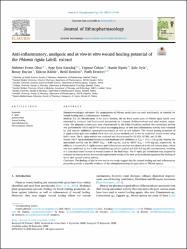Anti-inflammatory, analgesic and in vivo-in vitro wound healing potential of the Phlomis rigida Labill. extract

Göster/
Erişim
info:eu-repo/semantics/embargoedAccessTarih
2021Yazar
Okur, Mehmet EvrenKaradağ, Ayşe Esra
Özhan, Yağmur
Sipahi, Hande
Ayla, Şule
Daylan, Benay
Kültür, Şükran
Demirci, Betül
Demirci, Fatih
Üst veri
Tüm öğe kaydını gösterKünye
Okur, M. E., Karadağ, A. E., Özhan, Y., Sipahi, H., Ayla, Ş., Daylan, B. ... Demirci, F. (2021). Anti-inflammatory, analgesic and in vivo-in vitro wound healing potential of the Phlomis rigida Labill. extract. Journal of Ethnopharmacology, 266. https://dx.doi.org/10.1016/j.jep.2020.113408Özet
Ethnopharmacological relevance: The preparations of Phlomis aerial parts are used traditionally in Anatolia for wound healing and in inflammatory disorders. Methods: For the identification of the active fraction, the air dried aerial parts of Phlomis rigida Labill. were extracted by methanol and fractionated successively by n-hexane, dichloromethane and ethyl acetate, respectively. The phenolic constituents were characterized by the Folin-Ciocaltheu method; the antioxidant activity was performed by ABTS and DPPH radical scavenging assays. In vitro anti-inflammatory activity was evaluated by LOX enzyme inhibition, spectrophotometrically as well as cell cultures. The wound healing properties of P. rigida extract gels were studied via in vitro cell culture methods and in vivo by excisional wound model using Balb-c mice. The P. rigida extract was analyzed and characterized by GC-FID, GC-MS, and LC-MS. Results: The P. rigida methanol extract showed moderate LOX inhibitory at IC50 = 19.5 ± 2.8 μg/mL whereas the antioxidant activity was by DPPH• IC50 = 0.89 mg/mL, and by ABTS• IC50 = 0.99 mg/mL, respectively. In addition, a remarkable P. rigida extracts anti-inflammatory activity was observed in the cell culture assay, which was then confirmed by the in vitro wound healing activity applied at 0.125–0.5 mg/mL concentrations, resulting in a dose-dependent increase in wound closure at the final stage. The P. rigida gel formulation was prepared to evaluate the extract in vivo, whereas the experimental results of the new gel formulation supported the findings of the in vitro wound healing activity. Conclusion: The findings of this in vitro and in vivo study suggest that the wound healing and anti-inflammatory properties provide a scientific evidence of the ethnopharmacological application of Phlomis species.
WoS Q Kategorisi
Q1Scopus Q Kategorisi
Q1Kaynak
Journal of EthnopharmacologyCilt
266Koleksiyonlar
- Makale Koleksiyonu [282]
- Makale Koleksiyonu [3777]
- PubMed İndeksli Yayınlar Koleksiyonu [4230]
- Scopus İndeksli Yayınlar Koleksiyonu [6574]
- WoS İndeksli Yayınlar Koleksiyonu [6631]

















